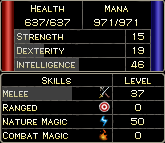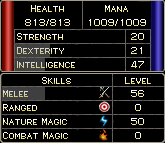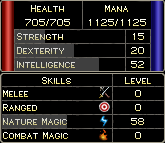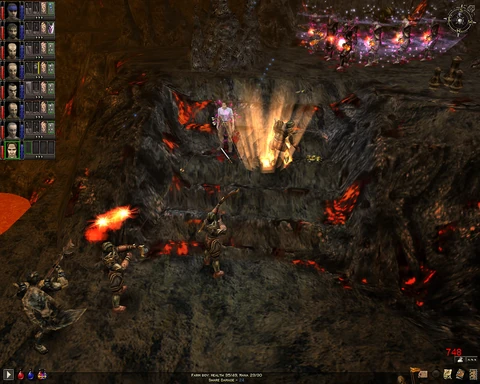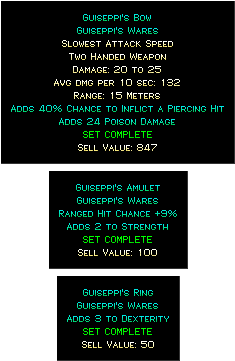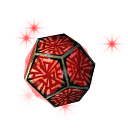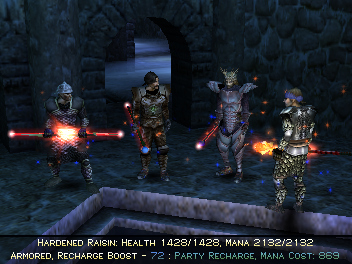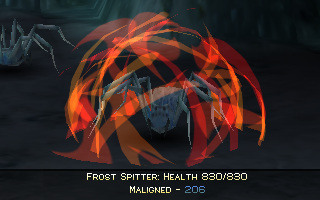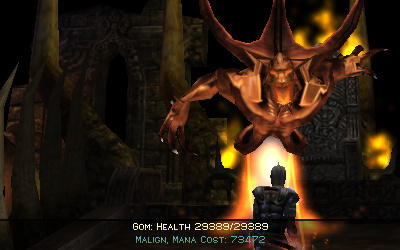This article aims to provide generally-relevant information about gaining experience in Dungeon Siege.
Levels
Dungeon Siege uses a multi-step process for tracking the hero's experience.
- First, xp is earned in each of the four classes separately: Melee, Ranged, Nature, and Combat. The raw point-totals are not reported onscreen. Points are given for dealing damage, not for making complete kills.
- Experience thus gained will increase his level in that discipline.
- It also adds the xp to a cumulative running total, something the devs call the character's uberlevel. The only time the player sees this number is in the multiplayer staging screen.
- Finally, the game allocates the uber-points back into separate categories: specifically, the bars for increasing Strength, Dexterity, and Intelligence. How this "attribute experience" is portioned-out depends on the class in which the xp was earned in the first place.
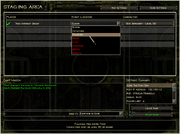
The uberlevel determines access to level-restricted content.
| Class | Strength | Dexterity | Intelligence |
|---|---|---|---|
| Melee | .64 | .27 | .09 |
| Ranged | .25 | .62 | .13 |
| Nature | .09 | .18 | .73 |
| Combat | .13 | .17 | .70 |
- Kung Fu
In addition to the four classes there is also weaponless fighting, referenced internally as Kung Fu and used by all the monsters in the game that lack weapons.
When the hero uses Kung Fu, simply swinging his fists with no weapon equipped, it does not increase Melee xp. It does contribute uber xp, and because of this, it generates progress in Strength, Dexterity, and Intelligence. Progress is portioned-out the same as Melee (64% to Strength), but again, there is no increase in Melee experience. This fact provides the needed insight to draw conclusions about how the game assigns the "attribute experience."
Example
What does all the business with uberlevel mean in practice? It has ramifications for the attribute scores, and it means that characters will gain attribute points at the relatively slow rate of growth of their total experience. They cannot bolster their weak attributes quickly by switching fighting styles.
Consider the following example. A Nature mage has trained to Level 50. He suddenly has a mid-life crisis. His Strength is only 14. What is he doing to himself? He wants more Strength.
Naturally he will attempt to train Strength by switching to Melee. When he earns Melee xp, the game allocates to Strength at a 64% rate, rather than the 9% rate from Nature xp. But the problem here is that attribute points flow from the total experience, the uberlevel, so he has to gain quite a lot of low Melee levels to see the Strength bar complete its crawl from 14.5 to 15:
Not-too-long afterwards, when his uberlevel has increased from exactly 50 (first pic) to exactly 51 (below), it may be discernable from the strength bars that he has gained exactly .64 points in Strength, as predicted in the table in the previous section.
With such extensive Nature training already, it took almost 38 Melee levels to increase the uberlevel by 1 and pick up the 64% of a Strength point.
To reach, say, 20 Strength from his original 14.5 using Melee, he needs about (20 - 14.5) ÷ .64 = 8.6 uberlevels. Due to the exponential nature of Levels, his Melee skill ends up having to surpass his Nature level in order to gain these strength points!
If he had stayed the course with Nature for the entirety of these 8.6 levels, he would have gained 6.3 Intelligence rather than 5.5 Strength (recall from the table that Nature is more intensive on Intelligence than Melee is on Strength).
In practice, multiclassing in Dungeon Siege is a poor decision. Engaging level 50 foes in melee with less than 20 Strength, with low health and unsuitable armor and weapons, is unpleasant. It is likewise a chore for a Melee careerist to gain Nature xp beyond his Melee level, considering his pathetic mana supply.
XP Chart
| 1 | 70 | 51 | 11,263,782 | 101 | 126,731,805,919 |
| 2 | 650 | 52 | 13,066,188 | 102 | 155,243,764,829 |
| 3 | 1,450 | 53 | 15,156,978 | 103 | 190,170,914,494 |
| 4 | 2,350 | 54 | 17,582,294 | 104 | 232,956,672,834 |
| 5 | 3,350 | 55 | 20,395,661 | 105 | 285,369,226,800 |
| 6 | 4,650 | 56 | 23,659,167 | 106 | 349,574,605,408 |
| 7 | 6,650 | 57 | 27,444,833 | 107 | 428,226,194,203 |
| 8 | 9,450 | 58 | 31,836,207 | 108 | 524,574,390,477 |
| 9 | 12,950 | 59 | 36,930,200 | 109 | 642,600,930,913 |
| 10 | 17,100 | 60 | 42,839,232 | 110 | 787,183,442,946 |
| 11 | 22,000 | 61 | 49,780,637 | 111 | 964,297,020,188 |
| 12 | 27,800 | 62 | 58,283,859 | 112 | 1,181,261,152,309 |
| 13 | 34,300 | 63 | 68,700,306 | 113 | 1,447,042,214,156 |
| 14 | 41,300 | 64 | 81,460,453 | 114 | 1,772,624,014,920 |
| 15 | 49,191 | 65 | 97,091,634 | 115 | 2,171,461,720,855 |
| 16 | 58,327 | 66 | 116,239,830 | 116 | 2,660,037,910,626 |
| 17 | 68,882 | 67 | 139,696,370 | 117 | 3,258,543,743,095 |
| 18 | 81,054 | 68 | 168,430,631 | 118 | 3,991,713,387,870 |
| 19 | 95,071 | 69 | 203,630,102 | 119 | 4,889,846,202,719 |
| 20 | 111,190 | 70 | 246,749,453 | 120 | 5,990,058,900,910 |
| 21 | 129,706 | 71 | 299,570,658 | 121 | 7,337,819,456,193 |
| 22 | 150,954 | 72 | 364,276,635 | 122 | 8,988,826,136,414 |
| 23 | 175,317 | 73 | 443,541,456 | 123 | 11,011,309,319,686 |
| 24 | 203,567 | 74 | 540,640,862 | 124 | 13,488,851,219,194 |
| 25 | 236,338 | 75 | 659,587,634 | 125 | 16,523,840,046,091 |
| 26 | 274,352 | 76 | 805,297,430 | 126 | 20,241,701,359,039 |
| 27 | 318,449 | 77 | 983,791,930 | 127 | 24,796,081,467,402 |
| 28 | 369,600 | 78 | 1,202,447,693 | 128 | 30,375,197,100,145 |
| 29 | 428,936 | 79 | 1,470,301,002 | 129 | 37,209,613,750,256 |
| 30 | 497,766 | 80 | 1,798,421,306 | 130 | 45,581,774,146,643 |
| 31 | 577,609 | 81 | 2,200,368,678 | 131 | 55,837,670,632,215 |
| 32 | 670,226 | 82 | 2,692,754,209 | 132 | 68,401,143,827,042 |
| 33 | 777,662 | 83 | 3,295,926,485 | 133 | 83,791,398,490,705 |
| 34 | 902,288 | 84 | 4,034,812,522 | 134 | 102,644,460,453,692 |
| 35 | 1,046,855 | 85 | 4,939,947,918 | 135 | 125,739,461,358,351 |
| 36 | 1,214,551 | 86 | 6,048,738,778 | 136 | 154,030,837,466,559 |
| 37 | 1,409,080 | 87 | 7,407,007,581 | 137 | 188,687,773,199,113 |
| 38 | 1,634,732 | 88 | 9,070,886,865 | 138 | 231,142,519,471,492 |
| 39 | 1,896,489 | 89 | 11,109,138,988 | 139 | 283,149,583,655,156 |
| 40 | 2,200,128 | 90 | 13,605,997,839 | 140 | 346,858,237,280,144 |
| 41 | 2,552,348 | 91 | 16,664,649,931 | 141 | 424,901,337,970,755 |
| 42 | 2,960,924 | 92 | 20,411,498,744 | 142 | 520,504,136,316,754 |
| 43 | 3,434,872 | 93 | 25,001,388,540 | 143 | 637,617,564,290,602 |
| 44 | 3,984,651 | 94 | 30,624,003,540 | 144 | 781,081,513,558,566 |
| 45 | 4,622,395 | 95 | 37,511,706,915 | 145 | 956,824,851,411,821 |
| 46 | 5,362,179 | 96 | 45,949,143,550 | 146 | 1,172,110,440,282,060 |
| 47 | 6,220,327 | 97 | 56,285,003,427 | 147 | 1,435,835,286,648,100 |
| 48 | 7,215,779 | 98 | 68,946,431,776 | 148 | 1,758,898,223,446,500 |
| 49 | 8,370,504 | 99 | 84,456,681,504 | 149 | 2,154,650,321,024,540 |
| 50 | 9,709,985 | 100 | 103,456,737,421 | 150 | 2,639,446,640,557,650 |
Exponents and Grind
Since experience is awarded for dealing damage, characters in a party will gain only a fraction of the experience points of a character running solo. But the table in the previous section brings good news to cooperative heroes: since levels are exponential benchmarks, a party's effective levels will not lag far behind a soloist.
The xp's from monsters in Dungeon Siege also rise exponentially... until they reach a plateau at the end of the Elite mode. Players will start feeling this plateau in the 80-to-85 range, and level-ups will begin to drag.
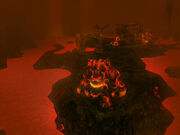
Subsequent levels in the 100's take truly extreme amounts of effort. If a player cleared the Elite-mode Volcanic Caverns three times daily, it would take four thousand years to become a Grand High Siegemaster (150 in all four disciplines). But it is unclear whether the game can actually track experience gains for high-level characters properly. A Level 146 character, whose experience totals are only saved in increments of 10 billion, might not get any experience at all for fighting unmodded monsters.
Multiplayer Scaling
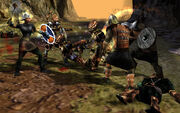
In multiplayer, the hitpoint and xp ratings, but not attack or defense, of monsters will be adjusted with the number of clients connected, according to the table below:
| Clients | hp | xp |
|---|---|---|
| 1 | 0.35 | 0.35 |
| 2 | 0.5 | 0.59 |
| 3 | 0.8 | 0.8 |
| 4 | 1 | 1 |
| 5 | 2.15 | 1.25 |
| 6 | 3.1 | 1.5 |
| 7 | 4.17 | 1.75 |
| 8 | 5 | 2 |
- In single player
- Regardless of how many party members are deployed the health and experience values of monsters will always be multiplied by 1, which is unlikely to change them much.
Difficulty Setting
This changes the players' and monsters' relative attack and defensive strength.
Setting the game's difficulty to Easy can be good when playing with kids. Setting it to Hard can be good when playing with in-laws, or to otherwise add realism to battles.
| Setting | Players | Monsters |
|---|---|---|
| Easy | 1.35 | .5 |
| Medium | 1 | 1 |
| Hard | .85 | 1.45 |
Each hitpoint on each monster yields the same experience value, so the total experience available in an Easy world and a Hard world is the same. But because the player deals only 85% damage on the hard setting, the player simply makes slower progress through the hard world in travelling and leveling up.
On the other hand, weapons dropped from enemies on the hard setting always sell for 2/3 of their base value. Weapons dropped on the easier settings are marked-down more severely and non-linearly with respect to their base value.
Experience for Damage-over-time (DoT)
Tests reveal that spells and martial weapons carrying DoT effects award experience differently from instantaneous damage. Examples of Damage-over-time attacks:
- Melee and Ranged weapons that proc Poison and Acid damage (see Prefixes)
- Captured Goblin weapons like the Flamethrower and Dragon Minigun
- Most Combat-aligned fire and all acid spells
- Some Nature-aligned light spells
Examples of Instant damage:
- Melee weapon swings
- Shots from bows and crossbows
- Fireshot
- Zap
When lower-leveled players use DoT attacks against higher-leveled enemies, their experience gains are massive, potentially more than the monster is actually worth. But high-leveled players get more experience when dealing instant damage against the same enemies.
To gain maximum xp at high levels, use instant damage.
The reasons for this are unclear. It may be because characters' experience point totals eventually get stored with scientific notation. A Level 100 character has more than 1E+11, or 100 billion, xp points and can only gain experience in increments of 1 million, so he needs to score instant hits for gains to be tracked with any semblance of accuracy.
Experience for reflecting damage
The series of of Reversal item suffixes can reflect hand-to-hand damage back at the attacker. A couple of spells do it, too. The effect does not function against ranged and magic attacks. When damage is reflected back at a foe, the player gains experience in whatever weapon or spell class he has readied, despite only reflecting hand-to-hand attacks.
The spells are:
- Shared Pain: Nature 50-70, duration 30-42 seconds, magnitude 50% damage reflection.
- Pain Reflux: Combat 38-58, duration 61-92 seconds, magnitude 30% damage reflection.
Experience for retaliation spells
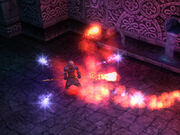
A DoT effect like drake fire tends to trigger all of a character's retaliation effects at once (pictured: Multi-Spark, Firebomb, Firespray).
LoA introduced a serious of magic armor suffixes that will randomly fire spells in retaliation for getting hit. This effect is triggered by all forms of attack, not just hand-to-hand like reflection. The spells are:
- Zap
- Fireshot
- Spark
- Firespray
- Fireskull
- Lightning
- Fireball
- Multi-Spark
- Lightning Blast
- Light Ray
- Starburst
- Firebomb
- Nova Strike
The magnitudes represent an ascending probability of the spell getting fired, as follows:
- of Lesser Zap - 10%
- of Minor Zap - 15%
- of Zap - 20%
- of Major Zap - 25%
- of Greater Zap - 30%
Damage dealt by these random spells will award xp to whatever weapon or spell class the player has readied; i.e., a triggered Firebomb awards xp to Nature skill if the player has Major Heal activated for casting.
Casting reload delays
Spells are given reload delays. Most are 1 second. Players might observe the difference in firing rates between Zap and Fireshot early on; Zap's reload delay is just 0.15 seconds.
Other spells have been "rebalanced" with long reloading delays, pursuant to the designers' often-dubious judgment in such matters. In most cases the lengthened delay puts the spellcaster entirely out of commission for that period. He cannot cast anything. So make sure the spell was worth it.
Some delays are understandable, as in the case of Cyclone of Fire (3s) which can deal huge damage and is fairly graphics intensive, or Meteor / Meteor Storm (5s) which are extremely graphics intensive.
Other instances of this mechanic reduce bad spells to laughable spells, as is the case with Storm and Lightning Storm (10s delay).
Literal Non-Factors
Quests
Completing certain quests in the game may trigger a scripted experience reward. The xp is assigned to the weapon or spell currently equipped. Most players remain completely unaware of this feature of Dungeon Siege, because the rewards in the default campaign settings are too trivial to notice.
User-created maps can, at the creator's discretion, generate big experience rewards using the existing conversational script components.
Casting Spells
Dealing damage is the main way to gain experience. The developers thought they would balance non-damaging spells and hexes, however, by awarding experience for casting such spells. Unfortunately these gains rapidly become trivial. Throwing a maximum-strength Major Heal spell awards 344 xp. Killing a Seck Grunt yields 82,000 xp.
This has an important implication. Hexes and support spells are useful, but allow spellcasters to spend most of their time throwing direct-damage attacks at the enemy. Otherwise, they will fall behind the team.
Destroying Containers
Containers are interactive objects with loot in them, like urns and barrels. The player may gain the aforementioned smidgeons of xp for casting spells at them, but will not gain xp for destroying the container.
Martial Weapon Recommendations
Melee and Ranged fighters have the relatively simple mandate of obtaining the best weapon they can find and using it. There are very few other concerns; these can be described in brief.
One-Handed Weapons
Legends of Aranna introduced a dps measurement on the tooltips for weapons and spells. Since xp is given for damage dealt, there is no difference in xp gained between 1-handers and 2-handers with the same dps. However, 1-handers allow the use of a shield.
Any character can carry a shield and gain the benefits of magical properties it conveys, but only melee fighters wielding 1-handers can make use of the highly desirable base properties of the shield, the ones written in white. Shields offer good inherent defense ratings and hard block rates against non-magic attacks.
DoT
As mentioned earlier, weapons can carry enchantment loads that inflict damage-over-time effects. Goblin guns do this normally. Again, damage over time can be a great way to train if the character's experience is especially low or the enemy's is especially high. In the endgame, it is better to rely on instantaneous damage, which the vast majority of martial weapons do.
Armor Piercing
An armor-piercing hit ignores the target's armor and deals exactly the damage given on the weapon or spell's tooltip.
Seeking out sources of armor-piercing is recommended. The harder the enemy, the stronger this mechanic gets.
- Sources of Armor Piercing
The only spells observed to ignore armor are Leech Life, Zorkon's Bonecrusher, and the Glpyh spells.
There are blue and purple mods that add a %Chance to inflict piercing hits, and ones that add straight integer piercing damage to attacks. Each one is limited to either Melee or Ranged.
- Main article: Prefix List (DS1)
- Main article: Suffix List (DS1)
Rune Series and Guiseppi's Wares are multiplayer-only sets that have high armor penetration, but the useful lifespans of their weapons are not very long.
The best source of armor piercing, at 50 percent, is the easter egg reward for completing Legends of Aranna, the Mac Daddy Cap. This hat affects both Melee and Ranged. It increases a character's attack power enormously.
Offensive Spells
Nature mages need a Zap spell to begin training, and Combat mages need Fireshot. This section will cover various attack spells of interest as the character levels up.
Best-of-breed
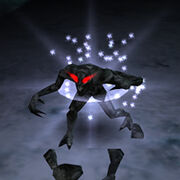
Flash
These are 1) easy-to-use, 2) deal average-or-better damage, and 3) have reasonable casting costs.
They go obsolete as the game progresses. In the level gaps between these spells, there is a dearth of satisfactory replacements that fulfill all three criteria.
- Flash: Nature 3-21
- Iceblast: Nature 24-52
- Icefury: Nature 54-78
- Explosive Powder: Combat 3-25
- Fireball: Combat 20-47
- Bomb: Combat 60-90
A mage should spend most of the campaigns with one of these spells loaded.
Training spells
Both of the magic schools have support spells that are useful to other classes. The DoT spells are good for cross-class training, because of the odd behavior of DoT when it comes to giving experience.
- Dancing Zap: Nature 6-26
- Shock: Nature 8-37
- Acid Glyph: Combat 2-22
- Acid Gas: Combat 1-20 (if no access to LoA)
They have exceptional experience yields when the skill is very low level and the monster is very high level.
Zorkon
Legends of Aranna introduced three Combat spells with unique offensive effects.
- Zorkon's Bonecrusher: Combat 17-37
- Zorkon's Disintegrator: Combat 25-65
- Zorkon's Exploder: Combat 75-150
Bonecrusher deals the damage given on its tooltip and is armor-piercing. But against Skeletons and a limited number of skeleton-like foes in LoA, the damage is multiplied by 18. Contrary to the tooltip, it does not get more expensive based on the power of the target. At the level cap, it strikes skeletons for about 900 damage (50 otherwise) and costs 27 mana against any foe, making it bar-none one of the most efficient attacks in the game.
Disintegrator kills the target. Mana cost goes down linearly from 2× the target's life at Combat 25 to 1× the target's life at 65 or greater. This spell can be moderately efficient and extremely fast, if the caster can afford it.
Disintegrator is always recommended over Exploder, which scales in the same fashion but to 150, and whose area-of-effect damage is trivial.
Grenades
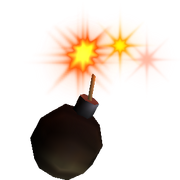
Three Combat spells produce a grenade-like object referred to in the data files as a "pineapple." These projectiles are fast, fun, and and can exceed their casting range by bouncing along the ground. The grenade spells are candidates for being a Combat mage's primary attack during their effective lifespans. Their damage ratings start very high but do not scale well beyond a few levels, but their ease-of-use never goes away.
- Explosive Powder: Combat 3-25
- Bomb: Combat 60-90
- Cluster Bomb: Combat 96-120
The casting range (white circle) and physical range of cluster bomb is pictured below. Explosive Powder and Bomb only fire one projectile, but it is more accurate.
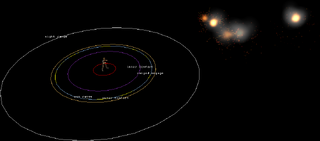
Poor-logistics spells
The aforementioned grenades have utility. As a counterpoint, here are examples of attack spells that are painful to enemies but can also be a pain to the player, for various reasons.
- Spark: Nature 4-24
- Multi-Spark: Nature 30-66
The homing projectile sparks move very slow and will collide harmlessly with walls, doorways, stalagmites, etc. At point blank range, the sparks move beyond the target to see if there are any obstructions to colide with first before heading back for the target.
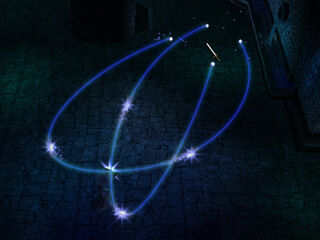
- Firebomb: Combat 70-90 - This spell deals 10 percent more damage than Bomb. But the projectile is very slow and its high, strange firing arc becomes a nuisance.
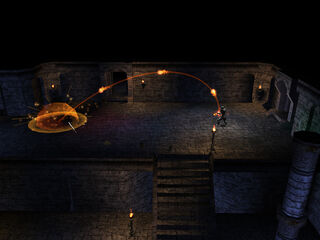
- Fire Wall: Combat 32-77
- Pillar of Fire: Combat 72-88
- Cyclone of Fire: Combat 90-120
Firewall costs too much for practical use. But its more advanced applications, Pillar and Cyclone, conjure wandering columns of flame. They deal so much damage that the player may wish to adjust tactics to accomodate their use. Enemies need to be tied-down, ideally stationary, for the flame columns to build momentum; once there are several columns of flame moving through a pack of foes, they will quickly get cooked.
Pillar makes a slow loop, passing through the target location twice, as shown:
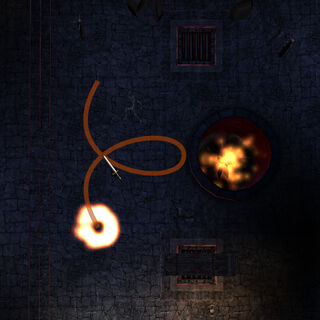
Cyclone moves more quickly and endures longer, making 2 full laps along this cloverleaf pattern and passing through the target location 8 times:
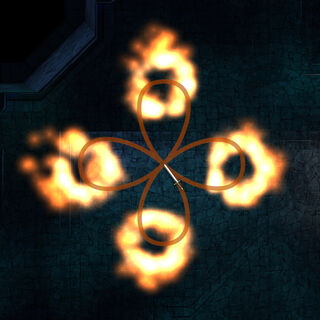
- Lightning Bolt: Nature 84-116
Probably the most difficult spell of all to pull off, this is a unique, turret-like spell, where the caster conjures a huge charge over his head that starts owning everything in sight, and quickly.
The problem with this arrangement is that the caster cannot move or be struck— not by anything— or the charge will terminate. The caster will need skilled (or carefully microed) comrades to draw enemies in range of the spell and keep them occupied. There does not appear to be any easy way to bring this spell to its full potential. It spell breaks Invisibility, and getting hit while Invincible still counts as getting hit.
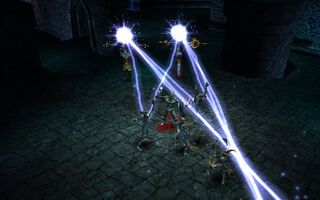
Glyphs
The stronger glyphs are no good for routine use, because they do not give experience. It is still a good idea to keep a Glyph in the spellbook as an emergency kill switch. They are, in fact, the best all-around skills in Dungeon Siege for clearing whole rooms, caverns, and fields of enemies at once. If they gave experience properly, they would all be in the "best-of-breed" section.
These spells come in several varieties for both Combat and Nature. The caster conjures a limited-duration proximity mine on the floor that will detonate when enemies draw near. The glyph can be cast directly at or near an enemy, and it will trigger immediately in that case.
- Acid Glyph: Combat 2-22
- Zapper Glyph: Nature 7-27
- Flaming Glyph: Combat 9-31
- Detonating Glyph: Combat 21-46
- Shockwave Glyph: Nature 22-42
Glyphs exhibit some erratic behaviors.
- All Glyphs except Acid ignore the enemy's armor rating, so they deal exactly their displayed damage.
- All except Acid have an effect radius of 10 meters, just about the largest AoE in the game.
- They can be used without breaking Invisibility.
- The Flaming and Acid Glyphs inflict DoT and give experience. The others do not.
Support Spells
Healing
- Healing Hands: Nature 0-39, efficiency ≈3
- Battle Healing: Combat 10-99, efficiency ≈2
- Major Heal: Nature 32-111, efficiency ≈4
Single-target heals are important in solo and parties.
At about 2 hp per mana spent, Battle Healing is less efficient than the two Nature spells. Major Heal is probably the best, if basic, support spell in the game, and becomes available before Healing Hands reaches its magnitude cap at 39.
Regen
- Healing Wind: Nature 9-46
- Reconstitution: Combat 24-84
- Nurture: Nature 46-111
These cover the whole party with a short-lived "healing breeze" effect. The magnitude of Healing Wind is abnormal, frequently healing several times the amount given on the tooltip.
These spells are especially powerful in combination with "life-balancing" enchantments should the party get access to them. Damage is divided among the party members, and then each one receives the full effect of these heals.
- Mana Chant: Combat 9-22
- Regeneration: Nature 18-44
- Party Recharge: Nature 58-78
Mana Chant increases the caster's mana regeneration rate. Regeneration increases the target player's health regeneration rate. Mana Chant is phenomenally useful, while Regeneration is easy to duplicate elsewhere.
Party Recharge is an expensive, high-level spell. It combines both of these effects and affects all party members in the area, who all simultaneously receive the stackable buff, "Recharge Boost."
Triple Strike
- Triple Strike: Combat 22-54
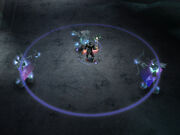
Triple Strike causes a character's melee swings to hit two additional targets in the area, tripling damage dealt. It is popular for experienced fighters to push Combat to 22 specifically to gain the ability to use this spell. The duration of the effect is always 20 seconds. Gaining levels beyond 22 does nothing but raise the casting cost of the spell by an additional 11.25 per level, from 250 to a max of 610.
Balancing
- Share Damage: Combat 15-35
- Mana Balance: Nature 46-66
- Life Balance: Nature 66-86
- Harmony: Nature 80-105
These have the effect of spreading wear-and-tear evenly around the party. It's hard to overstate how much this can improve your performance in battle. It takes a lot of pressure to kill the whole party at once. No single party member can get taken out by concentrated attacks, and the stock in wide-area spells like Healing Wind soars.
- Share Damage
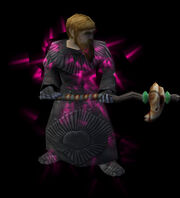
Share Damage vfx
- Share Damage is what players have to work with first. This spell is expensive and has a short duration that cannot be stacked. It has to be recast every 15 to 45 seconds as per the mage's skill level; party members in range all simultaneously get their own instance of the buff, and they are made immune to further castings of the spell until the duration runs out.
- On the plus side, the effect is somewhat more powerful than Life Balance. When one party member is attacked, it is as-if everyone is attacked; it triggers the Damage reflection and Retaliatory spells mods on all the party members.
- Damage received is mitigated by the recipient's armor, as normal, before being spread out. The attack is then distributed exactly in proportion to the current life-% of each party member; this can be observed in that (should the worst happen and the party gets wiped) everyone keels over at the exact same instant.
- Balancing
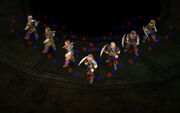
Life and mana-balancing vfx
- Life Balance, Mana Balance, and Harmony are higher-level Nature spells. With these, damage is confined to the party member that takes it, and the party's health is rebalanced post-fact. Anyone who is unconscious or dead is instantly resurrected, as long as there is aggregate health to spare. This rebalancing does not trigger retaliatory mods like Share Damage does.
- These spells put an enchantment on one party member, rather than taking effect on all members as with Share Damage. The enchanted party member radiates an aura conveying the spells' benefit to the other party members in the frustum (128m). The enchantments are long-lasting and stackable. Life Balance and Mana Balance are mutually exclusive if cast on one person, so don't do that.
- Harmony simply combines Life Balance and Mana Balance into one spell, saving room in the spellbook and time on the player's part, but is not otherwise different.
Targeted hexes
In Dungeon Siege there are spells that inflict debilitating enchantments on enemies. Creating effects like slowness, weakness, fear, or deception, players would normally associate these spells with crowd-control.
They have some problems: they don't actually affect crowds, their mana cost scales harshly with hp of the target, and they yield no significant amount of xp for casting. Of the entire list, only Slow Crowd affects more than one enemy, and both its duration and effect are pathetic.
Third-party modding can introduce these spells to the game by lowering their cost and giving them an area-of-effect.
- Vanilla
- Weaken: Combat 7-22
- Freak: Nature 5-23
- Oversight: Nature 22-44
- Charm: Nature 29-39
- Hold Creature: Nature 11-21
- Stumble: Nature 40-60
- Curse: Combat 26-36
- Return Summoned: Nature 58-78
- Polymorph: Nature 66-90
- Freeze: Nature 69-89
- Malign: Combat 80-111
- LoA
- Sleepy Gas: Nature 3-18
- Turncoat: Combat 3-24
- Light of Chadek: Nature 8-25
- Diminution: Nature 12-32
- Dimension Gate: Combat 12-35
- Block of Stone: Combat 22-47
- Slow Crowd: Combat 27-62
- Transference: Combat 41-68
- Example - Malign
Below, Malign weakens the victim's armor rating for a long time.
But against a foe where the spell and its long duration would be of actual use, it often has a five-figure mana cost.
- Example - Polymorph
Polymorph permanently turns a monster into a neutral ambient creature. Of course this preempts any experience and loot gained from just battling it out with the creature normally, causing one to wonder about the point of this spell. Polymorph has a quirk: it can target a foe in the tooltip's casting range (15m), but it just affects a random foe standing in melee range of the caster. Pic below is a demon being polymorphed for a tiny amount of mana when a distant Krug Scavenger is targeted.
- Example - Ambivalence
This spell has a flat mana cost unlike the others in this section, but has been rendered obsolete the Invisibility effect introduced in Legends of Aranna. The target is made neutral for a short period, but will resume attacking if attacked.
Floor hexes
- Spectral Image: Nature 55-80
- Monster Magnet: Combat 55-75
- Mindflare: Nature 75-95
- Tadzu's Trance: Combat 75-105
These spells have high level requirements, but unlike the spells in the above section, their costs do not scale to the hp of the target, and they can affect multiple enemies.
{{#vardefine:game| }} {{#vardefine:type| }} {{#vardefine:type| }}
[[Category:{{#var:game}}: {{#var:type}} Stub]]
| Item Lists - Dungeon Siege / Legends of Aranna | |
|---|---|
| PContent | Items • Enchantments by Type • Prefix List • Suffix List |
| Armor | Body Armor • Boots • Gloves • Helms • Shields |
| Weapons | Swords & Daggers • Clubs, Hammers, & Maces • Axes • Bows & Guns • Staves |
| Spell Items | Spells (Nature Magic - Combat Magic) • Spellbooks • Spellbook Affixes • Spell Guide |
| Other Items | Gold • Rings • Amulets • Potions • Treasure |
| Singleplayer Item Sets | Arhok's Lot • Illicor • Kajj • Solov • Demlock • Clockwork |
| Multiplayer Item Sets | Chadekian • Guiseppi's • Kaltenbach • Rune Series • Adela's • Jeffron's • Cicatrix • Utraean Archer • Zaurask Champion • Xulphae's • Kmethekt's • Utraean Guard • Ancient Hassat • Jerkal's |



